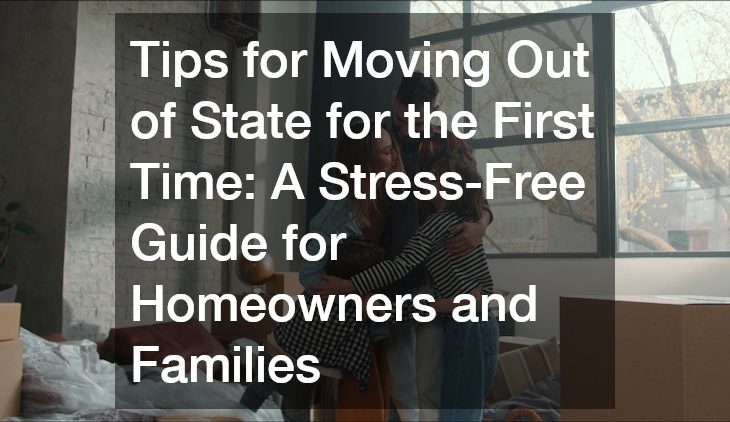Tips for Moving Out of State for the First Time: A Stress-Free Guide for Homeowners and Families

Relocating to a different state is a major life change, especially when it’s your first time. Whether you’re following a job opportunity, upgrading your lifestyle, or simply seeking a fresh start, moving out of state requires careful planning and a proactive mindset. For homeowners and families, this process can be especially complex with added responsibilities like selling a house, enrolling kids in new schools, and transporting pets.
In this article, we’ll walk you through practical and proven tips for moving out of state for the first time. From early planning to adjusting after the move, here’s everything you need to know to make your relocation smooth and manageable.
Why Does Moving Out of State Require Extra Planning?
When you’re crossing state lines, everything becomes more involved—from the logistics to legal requirements. Unlike a local move, out-of-state relocations often mean coordinating with multiple parties, budgeting for long-distance travel, and adapting to a completely new environment. For families, this includes finding suitable schools, securing healthcare, and settling into a new community.
Getting a head start can minimize stress and help you avoid last-minute scrambling. The more you prepare, the easier the transition will be for everyone involved, including kids and pets.
What Should You Do First Before Planning Your Move?
Before you pack a single box, there are foundational steps that can make your move exponentially easier. Taking care of these early tasks will help you feel more in control and organized.
Here’s what to do first:
- Research your new state and city. Understand the cost of living, job market, neighborhoods, and local laws.
- Visit in advance, if possible. Scope out schools, amenities, and real estate in person.
- Create a realistic moving budget. Include packing supplies, transportation, temporary lodging, and utility setup.
- Notify your employer and start planning job transitions. If you’re transferring jobs or changing careers, finalize these details ahead of time.
- Secure housing. Whether you’re buying or renting, having a place lined up ensures peace of mind on moving day.
How Can You Organize Your Packing for Maximum Efficiency?
Preparing to pack for a long-distance move can seem daunting, but having a clear system in place can make the process far more manageable. A strategic approach not only helps streamline your efforts but can also reduce unnecessary costs and stress.
Here are some smart packing suggestions to help you stay organized:
- Purge unnecessary belongings. Take time to go through your home and remove items you no longer use or need. You can donate gently used goods, sell items online, or simply discard what’s no longer useful.
- Label methodically. Assign a color or number system for each room, and mark your boxes accordingly. This will make unloading and unpacking at your new home much quicker.
- Prepare a “first-day” kit. Set aside a box with all your must-haves—think medications, phone chargers, toiletries, snacks, and important papers—so you’re not scrambling to find them later.
- Safeguard delicate items. Wrap glassware, electronics, and other fragile belongings carefully using bubble wrap or packing paper, and place them in sturdy boxes to prevent damage during transit.
- Consider professional help. For large or complex moves, hiring experienced movers with insurance and positive reviews can take a significant burden off your shoulders.
Tips for Moving Out of State for the First Time: What Makes It Different?
Out-of-state moves require a different mindset than local ones, especially when it comes to timing, transportation, and adaptation. If you’re looking for tips for moving across the country, or simply state-to-state, these will serve you well.
Here are the unique challenges and how to overcome them:
- Timing matters. Long-distance moves take more time—book moving companies and trucks at least 6-8 weeks ahead.
- Vehicle logistics. Will you drive your car or ship it? Don’t forget to change registration and insurance after the move.
- Licenses and registrations. Update your driver’s license, voter registration, and vehicle documents as soon as you move.
- Healthcare and insurance. Find new providers and transfer prescriptions early.
- School enrollments. Research school districts, gather transcripts, and contact school administrators in advance.
How Can You Prepare Your Family Emotionally and Practically?
Leaving behind familiar surroundings can be tough on children and adults alike. Being proactive about the emotional aspects of moving can smooth the transition and create a more positive experience for everyone.
Some helpful tips:
- Talk to your kids early. Involve them in the moving process and keep communication open.
- Say goodbye properly. Host a small farewell party or visit favorite local spots one last time.
- Establish routines quickly. Familiar routines help children feel secure in a new environment.
- Stay positive and patient. Adjusting takes time—give your family space to settle in at their own pace.
What Happens After You Arrive in Your New State?
Once you’ve arrived, the focus shifts to settling in. The first few weeks are key to establishing your new normal.
Here’s what to prioritize:
- Unpack strategically. Start with the kitchen, bathrooms, and bedrooms to get comfortable fast.
- Set up utilities and internet. Get connected as soon as possible to avoid disruptions.
- Explore your community. Visit parks, grocery stores, and local services. Introduce yourself to neighbors.
- Register locally. Complete address changes, register with a new doctor, and set up local banking if needed.
- Join groups or clubs. Look for community events or organizations to help you make connections.
Conclusion
Moving out of state for the first time is a major life milestone. For homeowners and families, it involves balancing logistics, finances, and emotional transitions. But with thoughtful planning, a good support system, and a clear checklist, it can be a smooth and even exciting experience. Follow the steps outlined above to ease your move, avoid common pitfalls, and start the next chapter of your life with confidence.


